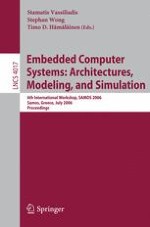2006 | Buch
Embedded Computer Systems: Architectures, Modeling, and Simulation
6th International Workshop, SAMOS 2006, Samos, Greece, July 17-20, 2006. Proceedings
herausgegeben von: Stamatis Vassiliadis, Stephan Wong, Timo D. Hämäläinen
Verlag: Springer Berlin Heidelberg
Buchreihe : Lecture Notes in Computer Science
